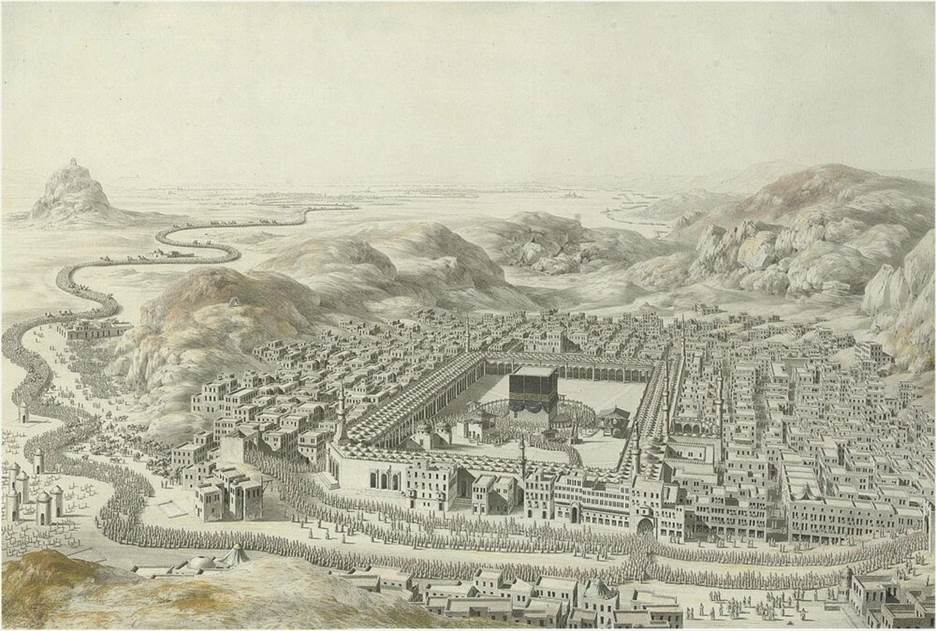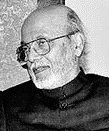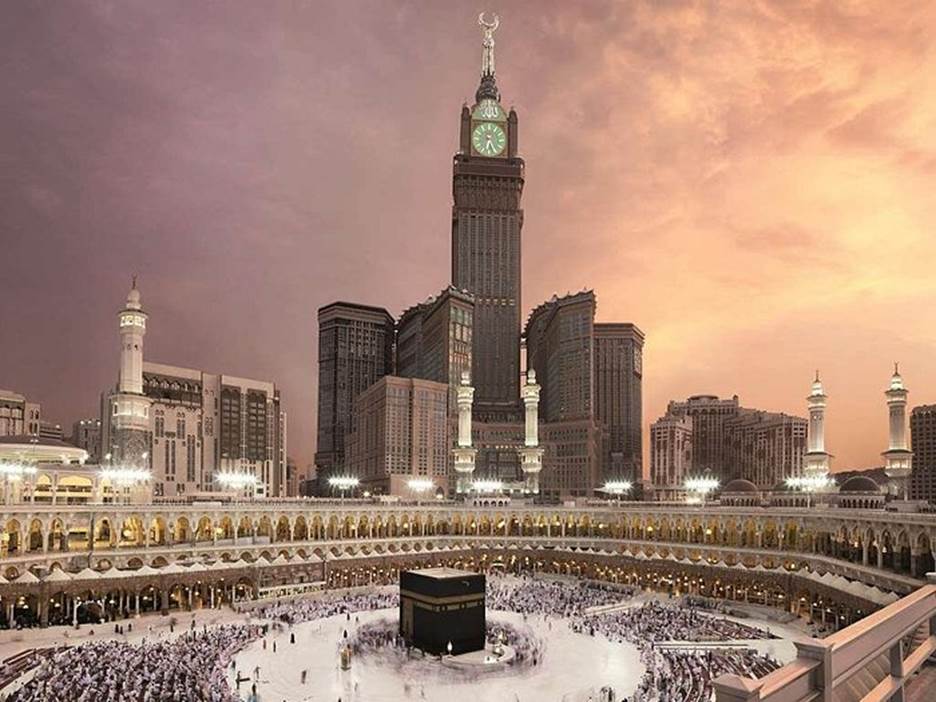

The alleys where the Suhaba walked have disappeared. The trenches dug by the very hands of Prophet Muhammed (peace and blessings be upon him) have been filled in and paved over with parking lots. The hills that trembled with Azan e Bilali have been dynamited piece by piece to make room for tall buildings. Mecca is now an urban sprawl – Cities from Salt
Finding God in Urban Sprawls
By Dr Nazeer Ahmed
Concord, CA

Today, the Ka’aba is like a pearl dropped into a fishbowl. Gone are the hills that echoed the Azan of Bilal (r) and reverberated with the sound of Allahu Akbar. Gone are the valleys that first heard the call of Tawhid, La Ilaha Il Allah. Gone also are the homes where lived the Ahl e Bait.
The alleys where the Suhaba walked have disappeared. The trenches dug by the very hands of Prophet Muhammed (peace and blessings be upon him) have been filled in and paved over with parking lots. Mecca is now an urban sprawl. The hills that trembled with Azan e Bilali have been dynamited piece by piece to make room for tall buildings. The valleys that basked in the warmth of Tawhid are filled in with concrete. You can drive miles in any direction from the Ka’aba and you see blocks after blocks of concrete structures. The Azan from the Ka’aba resonates not from the hills of Mecca but is bounced back from the high-rise hotels that surround it.
The urbanization of Mecca is not unique among the sacred cities of the world. Rome and Jerusalem have suffered the same fate. The serenity of nature that gave birth to the great religions of man has been replaced by the cacophony of automobile horns and the hum of internal combustion engines. Modern man has to search for God not in the wilderness of the dessert or the seclusion of the forest but in the cacophony of life in mid-town Manhattan or the traffic jams in Jakarta.
There was a time in ancient Mesopotamia (Iraq) when a young man named Ibrahim (pbuh) looked up at the desert sky and contemplated on who created it all. He saw a bright star and said, “Ah! That is a bright one. Surely, it is my God”. But when the star set, Ibrahim (pbuh), realized that which sets is not worthy of worship. There rose the moon with its serene beauty, caressing the sand dunes of the Iraqi desert with its enchanting rays. “That is my Lord”, said Ibrahim, “it is so much bigger than a star”. But the moon, too, traversed the sky and disappeared and Ibrahim (pbuh) was disappointed. Came the dawn and there rose the sun in its resplendent grandeur. “Surely, that is my God”, cried out Ibrahim (pbuh), “it is so bright”. Evening came and the sun set, and Ibrahim felt “sick in his heart” until in a moment of illumination he became aware of God, the Creator and Sustainer of all the Worlds.

The Ka’aba is now hemmed in with skyscrapers that look down upon it from a thousand feet in the air. Where the pilgrims looked up at the Ka’aba, they now stare at a clock tower and take pictures – TripAdvisor
Where would modern man find the serenity that surrounded Ibrahim when he searched for his Rabb? In the skyscrapers of Manhattan? In the skyline of Beijing? In the lights of the Eifel Tower or the Juhu Beach of Bombay? Alas, the search will ratchet back to the inquirer. The concrete jungles that surround modern man are opaque curtains that separate the divine light within the heart from its perception by the mind. Humankind is lost in trivial pursuits, chasing worthless gold or digital money, oblivious of who he is and why he was created on this speck of dust called the earth. And a speck of dust it is.
In the vastness of the cosmos whose extent we do not know, there are more than two billion galaxies, each galaxy has more than two billion stars, each star several planets. Tucked away on the fringes of a midsize galaxy, namely, our own milky way is a dwarf star, our sun and here is our earth, one of the smaller planets circling around the sun. It is so tiny that it does not even show up in the largest Atlases of the heavens. On this tiny speck of dust there are seven billion of us, marching headlong into the netherlands of urban life, losing sight of where we came from and oblivious of our destination. The human has forgotten who he is, what he is here for, and where he is going.
I have just returned from Umrah. This was my fourth visit to the sacred predicts of the Ka’aba. At the age of 84, I can look back at my previous visits from a temporal perspective. The first was my Hajj in 1977. We were on the Plain of Arafat when we heard that Anwar Sadat of Egypt had travelled to Jerusalem. Mecca was then a growing city. The hills around the Ka’aba were still intact. You could visit the Qandaq (the trench) dug by the Prophet and his companions during the Battle of the Qandaq. The mosques associated with the Suhaba, located some distance away from the Ka’aba invited the pilgrims to walk in and offer two rakats of Nafil prayer. The graves of Ahl e Bait in Jannatul Baqi could still be identified.
That Mecca has disappeared. It is now a full-grown metropolis. The Ka’aba is now hemmed in with skyscrapers that look down upon it from a thousand feet in the air. Where the pilgrims looked up at the Ka’aba, they now stare at a clock tower and take pictures. The path to the Ka’aba is lined with fashionable stores, reminiscent more of the airport at Singapore than anything that exudes spirituality, Islamic history and culture. If you survive the visual onslaught of brazen and enticing commercialism you enter the precincts of the haram with a jarring suddenness as if you wake up from a visit to Madison Avenue to the sacred predicts of Maqam e Ibrahim. Now, the internet takes over. Where you once heard the recitation of dua’s you now hear the click of selfies. The ubiquitous presence of the mobile phone has taken the place of the tasbeeh. Indeed, you cannot even get into the inner sanctum of the haram unless you show your mobile phone with an official App on it. Sanctity indeed!
Surrounded by this discordant cacophony of urban life, what can modern man do? How can he search for God in an urban sprawl? What guidance does the Qur’an offer for this echo chamber? Fortunately, both science and tasawwuf (spirituality) come to the rescue of man and reinforce the guidance from the Qur’an.
When we build a space sensor such as the Hubble Space Telescope or detectors for a homing rocket, one of the main requirements that drives the design is the Signal to Noise Ratio (SNR). The signal is the light, the heat, or, in general, the electromagnetic radiation from the target which could be a star or a man-made object. The “noise” is the radiation from all objects, other than the target object. It is important to maximize the Signal to Noise Ratio to learn something about the target. The signal is our goal; the noise is the distraction. On the Hubble Space Telescope, which was one of the finest instruments built by humankind in the twentieth century, we spent millions of dollars designing light shields to keep stray radiation out. The result was the discovery of new galaxies with utmost clarity. The views were transformational; they changed the way humankind looked at itself.
Apply this to modern life. The human was created to know, serve, and worship God (Hadith e Qudsi: “I was a hidden treasure. I willed that I be known. Therefore, I created a being who would know Me”). To discharge this responsibility, he was anointed with the regency of the earth. The “Signal” for the human is the light in the innermost heart (the Fuad) that comes from the presence of God. All else is distraction; it is the undesired and undesirable “straylight”.
How can modern man maximize his SNR? Here, the Qur’an offers him guidance. One of the oft-repeated dua’s is Allahumma A’inni ‘Ala Zikrika, Wa Shukrika, Wa Husne Ibadatik (O God! Show us how to remember you, to be thankful to you, and to excel in your service and your worship). This supplication offers a four-step ladder to divine presence and inner peace: Zikr (dhikr or remembrance of God’s Name), Shukr (sincere gratitude for heavenly blessings), Ehsan (excellence), (Ibada) service and worship.
Dhikr is one of the pillars of tasawwuf. Indeed, all Sufi tareeqas are built upon two fundamental principles: dhikr and sohbet or companionship of the saleheen (the truthful ones). A Sufi sohbet on a Thursday night (the beginning of the Islamic week) is a gathering of seekers to remember God, send salawat on His beloved messenger and hear a few words of wisdom from a person of spiritual knowledge. Let the heart of modern man beat with the Name of God, every heartbeat, every minute, every day till death silences the heart. That is the heavenly “Signal”. It radiates its light from Noor e Muhammadi (the Light of Muhammed).
When the King (the Name of God) is in the heart, it suffuses it with its peace and all other powers are dispelled from that space. Modern man is then aware of his noisy surroundings, as he must to survive in an urban jungle, but he is disengaged from its distractions. Let me elaborate with a Sufi teaching. Once Hazrat Uthman (r) was asked: What do you see in God’s creation? He replied: “I see God through his creation”. Then Abu Bakr Siddique (r) was asked the same question. “I see nothing but God” was his answer. There is infinite wisdom in this teaching.
Modern man can find God in urban sprawl through unceasing silent dhikr of the heart, thankfulness of the infinite blessings that surround him and excellence in service and worship. A man or a woman reinforced with silent dhikr is a citadel, with peace and serenity within, not distracted by the cacophony of modern life, not overwhelmed but riding the waves of technology that come at him while discharging his heavenly mandate to know, serve and worship God.
SNR
Dhikr
Allahumma A’inni ‘Ala Zikrika, Wa Shukrika, Wa Husne Ibadatik . Aware but be detached. The example of Ibrahim. Example of Uthman and
Dhikrs sessions instead of D’awat brigades, soot boot and sarees
(The author is Director, World Organization for Resource Development and Education, Washington, DC; Director, American Institute of Islamic History and Culture, CA; Member, State Knowledge Commission, Bangalore; and Chairman, Delixus Group)

